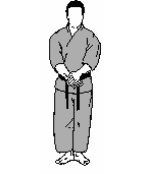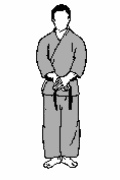Kata
The most popular image associated with kata is that of a karate practitioner performing a series of punches and kicks in the air.
The kata are executed as a specified series of approximately 20-plus moves, generally with stepping and turning, while attempting to maintain correct form.
There are Many different kata across the various forms of karate, each with many minor variations. The number of moves in a kata may be referred to in the name of the kata, e.g., Shisochin which means "to destroy in 4 directions" and Sanchin which translates to 3 Battles.
The number of moves may also have links with Buddhist spirituality. The number 108 is significant in Buddhism, and kata with 54, 36, or 27 moves (divisors of 108) are common.
The practitioner is generally counselled to visualize the enemy attacks, and his or her responses, as actually occurring, and karateka are often told to "read" a kata, to explain the imagined events.
The study of the meaning of the movements is referred to as the bunkai, meaning analysis or applications of the movements of the kata.
One explanation for the use of kata is as a reference guide for a set of moves. Not to be used following that "set" pattern but to keep the movements "filed". After learning these kata, this set of learned skills can then be used in a sparring scenario (particularly without points). The main objective here is to try out different combinations of techniques in a safe, practice environment to ultimately find out how to defeat your opponent.
There are claims that most antique karate kata were developed for use with weapons rather than as open hand techniques.
Kata is also often described as the "bible" of karate.
In kata, the blocking movements are often performed while moving forward, which wouldn't be practical during the 'Bunkai'. These blocking movements would be performed during a Tai sabaki (体捌き), stepping-back action or evasive movement, where the opponent's attack would be avoided and the block would be a mere cover.
These kata were performed in this backward/incorrect way as it left the true intentions of the movements elusive to spying onlookers as karate was once a closely guarded secret revealed only to the most diligent students.
The true kata can be performed by advanced students who have a good feel for taisabaki and the dynamics of evasion.
This description courtesy of Wikipedia.
BELOW ARE THE FIRST THREE KATA (FORMS) WITHIN THE SYLLABUS WE FOLLOW WHICH IS OF THE INTERNATIONAL GOJU RYU KARATEDO FEDERATION (I.O.G.K.F).
GEKISAI DAI ICHI

GEKISAI DAI NI
SAIFA
